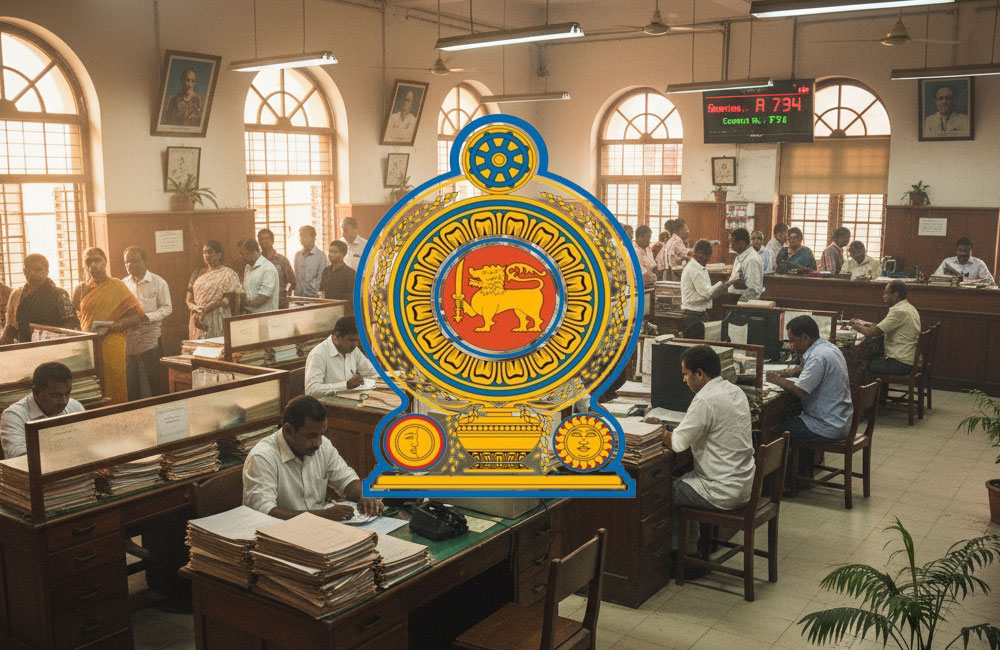Sri Lanka’s long-standing public sector overstaffing problem has re-emerged as a critical economic threat in 2025, with new data showing that the state machinery already one of the largest in South Asia continues to drain scarce fiscal resources and obstruct national productivity. Government officials, including Deputy Minister of Industries Chathuranga Abeysinghe, now openly admit that the system is “bloated at the bottom tier” due to decades of politically driven recruitment.
As of 2025, Sri Lanka’s public sector including ministries, departments, state-owned enterprises (SOEs), statutory bodies and security forceshas swollen to approximately 1.38 million employees, edging closer to its approved cadre of 1.5 million. This makes the public service larger than the total private-sector workforce employed by the country’s top 50 corporations combined. Yet productivity indicators remain stagnant, and service delivery continues to deteriorate, particularly in education, healthcare, and local administration.
Speaking at a Deloitte post-budget forum, Deputy Minister Abeysinghe acknowledged a truth that previous governments avoided. “The public service has been expanded artificially, largely at the bottom, where jobs were handed out as political favours. What we are trying to do now is rightsizing—supported by technology to restore efficiency,” he said. The 2025 Budget’s proposed 75,000 new recruitments, he emphasized, would focus strictly on essential skilled categories such as nurses, teachers, and engineers, rather than unqualified general staff.
The most controversial segment remains the so-called “Development Officers”—a politically inflated cadre of graduates placed in state offices often without defined duties. As of January 2025, Sri Lanka employed nearly 104,000 Development Officers, despite an approved cadre of 78,000. Many report to district or divisional secretariats where, according to senior officials, “there are not enough desks or functional tasks for them.”
This surplus workforce places a heavy burden on public finances. Salaries, allowances, pensions, and overtime consume almost 86% of government revenue, leaving limited room for development spending. Sri Lanka’s public-sector wage bill is now one of the highest in Asia relative to GDP. Economists warn that unless the system is restructured, the country’s recovery from the 2022 financial crisis will be slowed significantly.
A second structural problem is the expanded post-war military. Unlike countries that downsized after conflict, Sri Lanka never undertook a demobilisation program. Nearly 40,000 personnel from the 2006–2009 recruitment wave will complete 20 years of service over the next three years. The government now faces the challenge of upskilling and reintegrating them into the economy, while thousands of deserters remain outside the formal system, limiting the country’s productivity potential.
Despite promises of voluntary retirement schemes, the government insists there will be no mass layoffs. Instead, it expects digitalisation to gradually “rightsize” ministries within three to five years. However, experts caution that without skill development, performance evaluations, and enforcement of merit-based hiring, digitalisation alone cannot fix structural inefficiency.
The consequences are already visible: parents opting for private education despite paying taxes for state schooling; patients “channeling” private doctors due to failing hospitals; and taxpayers subsidising loss-making SOEs, including enterprises re-nationalised during the Rajapaksa era.
With Sri Lanka aiming for long-term economic stability under IMF-guided reforms, analysts argue that meaningful public-sector restructuring is no longer optional—it is the cornerstone on which the country’s future progress depends.

Leave your comments
Login to post a comment
Post comment as a guest